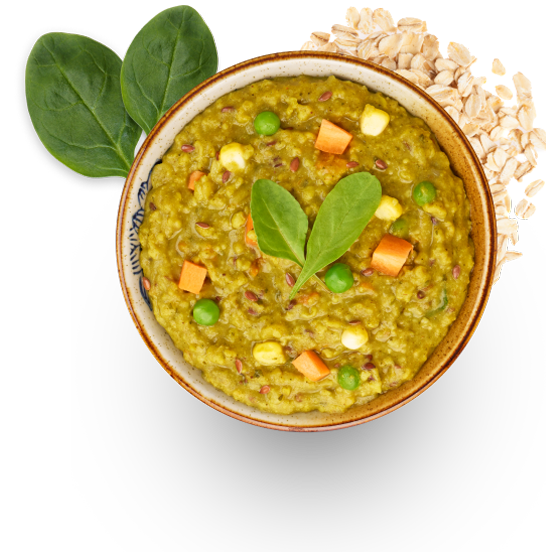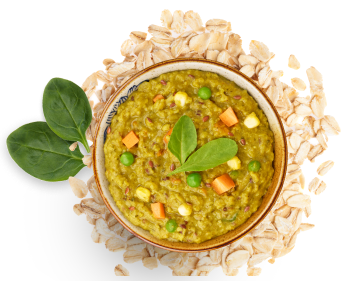Types & Health Benefits of Millets
Blogs08 Mar 2024
IN THIS ARTICLE
Before our country consumed rice and wheat so widely, Indians consumed these “forgotten grains” called millet. And now again, as we are growing more health conscious and mindful in our eating habits, it’s the right time to rediscover these nutrient-rich grains, also known as superfoods! According to ICMR, older adults are prone to nutritional deficiencies. This is why they must consume nutrient-dense foods that are nutrient-dense and wholesome. Millets with their high fibre, micronutrient content and array of health benefits make them a great dietary addition for someone looking to eat healthy and lose weight in their midlife. In this article, let us take you through the world of these super grains, their types, millet health benefits and recipes!
What is a Millet?
Millets are ancient cereal grains that have been staples in Asia and Africa for centuries. While being widely consumed for generations, the production and farming of millets has gone down in the past five decades due to the rise of rice and wheat, among other grains. However, millets offer a nutritional profile unlike any other. They are sources of energy, fibre, micronutrients and more that they are gaining attention again for their numerous millet benefits!
Nutrition in Millets: Unravelling the Goodness
Millets offer a wide variety of nutrients including vitamins, minerals, proteins and dietary fibre. They might have antioxidant, anti-hyperglycaemic, anti-cholesterol, and anti-hypertensive effects on the body. Additionally, millets are a source of calcium, iron, magnesium, potassium, zinc, and Vitamin B. Did you know that research has found millets to be nutritionally richer than rice and wheat? So, the next time you miss a hot bowl of khichdi, why not make one with millets? We do have more recipe suggestions below. Keep reading to know more.
Types of Millet Grains: Exploring the Diversity
There are many different types of millets grown across India. Some of the main millet benefits that are popular in the country are:
1. Foxtail Millet (Kagni)
Commonly used to make Upma and Dosas, foxtail millet contains protein, high dietary fibre, vitamins, minerals, and resistant starch. Foxtail millet shows essential ingredients which may help in maintaining a healthy lipid profile.
2. Pearl Millet (Bajra)
Bajra, a staple in Indian households, contains a lower amount of carbohydrates and a high amount of Omega-3 fatty acids. It also contains micronutrients such as iron, zinc, copper, Potassium, Magnesium and B Vitamins. It is entirely gluten-free and produce a lower glycaemic response in users. The major health benefits of pearl millet include potentially reducing the risks of lifestyle disorders such as diabetes and cardiovascular conditions.
3. Finger Millet (Ragi)
Finger millet or Ragi is a very popular millet type in South India. It is a source of protein, iron, fibre and vitamins. And most importantly, ragi contains the highest amount of calcium content (364mg in 100g) in any food grain! This is why it is commonly fed to babies, expecting mothers and senior citizens. It’s slow to digest, thus promoting satiety and balancing blood glucose levels too.
4. Sorghum (Jowar)
Jowar is a gluten-free grain that is a source of fibre and antioxidants. It has high protein and fibre content along with several other important micronutrients. Other than having a low glycemic index, Sorghum is also a sustainable crop that grows in a variety of colours like white, red, brown and black.
5. Proso Millet
A source of B vitamins, folic acid, niacin, and essential amino acids, Proso millet, is a gluten-free grain. It contains calcium along with other minerals such as zinc and phosphorus.
6. Little Millet (Kutki)
The benefits of little millet are that it contains an abundance of dietary fibre, starch, protein and amino acids. Little millet is also a source of Iron, and Niacin, making it a great addition to your diet to support your overall well-being.
7. Kodo Millet
Kodo millet or Kodon millet is a more digestible millet type that may have positive, strengthening effects on the nervous system. It is not only a source of essential vitamins and minerals but may also promote cardiovascular health and balance cholesterol levels!
8. Barnyard Millet
Barnyard millet, also known as Sanwa, is a source of calcium, iron, phosphorus and dietary fibre. It might help boost bowel movement and strengthen bone density. This millet may be a suitable choice for diabetic patients due to its low glycemic index.
Millet Health Benefits: A Holistic Approach to Well-being
Now that you’ve understood the types of millets and their benefits, let us look at their overall impact on health. Here are all the millet food benefits that you should know about:
1. Heart Health
Millets may be heart-friendly, helping to reduce cholesterol levels and might maintain a healthy cardiovascular system. The fibre content aids in controlling blood pressure and cholesterol levels and delaying heart-related issues. Hence, once you enter your 40’s it might help you immensely if you include millet in your diet.
2. Weight Management
With their high fibre content, millets may contribute to a feeling of fullness, making them an excellent choice for weight management. The slow digestion of millet might help regulate blood sugar levels, and your future calorie intake, in turn promoting weight loss.
3. Digestive Health
As you age, your gut tends to become weaker. It might not be able to digest food like it used to before. Here, millets can come to your rescue. Millets offer huge amounts of dietary fibre, amino acids and starch while being gluten-free which might improve satiety and promote gut health and digestion. Millets are especially suitable for individuals suffering from gluten allergies, Celiac disease and more.
4. Diabetes Management
Millets feature a lower glycemic index than many other foods, which might help maintain stable blood glucose levels. This is why millets may be well suited for people with diabetes. There are many ways in which millet can be added to a diabetic-friendly diet to get its benefits! If you are diabetic, then you can sure approach your doctor and explore the option of including millets to your diet.
Simple Millet Recipes: Embracing Healthy Eating
1. Foxtail Millet Upma
Whip up a nutritious breakfast with foxtail millet upma. Sauté vegetables, add soaked foxtail millet, and let it cook to perfection. Season with spices and garnish with fresh coriander for a wholesome and delicious start to your day.
2. Pearl Millet Roti (Bajra Roti)
Bajra roti is a traditional favourite. Mix Bajra flour with water, knead into a dough, and roll out rotis. Cook on a griddle until golden brown. Pair it with a side of vegetables or dal for a nutritious meal.
3. Finger Millet Porridge (Ragi Kanji)
Start your day with a hearty ragi porridge. Boil ragi flour in water, stirring continuously to avoid lumps. Add milk, sweetened with jaggery, and top with nuts for a wholesome breakfast that provides sustained energy.
4. Sorghum Salad (Jowar Salad)
Jowar salad is a refreshing and nutritious option. Cooked Jowar grains are mixed with colourful vegetables, herbs, and a zesty dressing. This salad is not only delicious but also packed with essential nutrients.
Summary
Millets are gluten-free, fibre-rich, nutrient-dense grains that make for great alternatives to rice and wheat. They are filled with essential micronutrients that may support heart health, bone health and digestive health. Millets are very versatile and can be used to make a range of staple dishes. Adding millet to your diet in your 40s-50s could be a great way of choosing better ingredients to boost your overall well-being and help manage your weight.
FAQs
Yes, the nutrition in millet is very high and can be added to your diet daily. Their wide range of nutrients, high fibre content and gluten-free nature make them perfect for regular consumption. However, if you have digestive issues, make sure to check with your doctor before increasing your millet intake.
Millets are known to be more nutritious than rice and hence come as a great alternative to the staple food that rice is.
While millets are generally well-tolerated, individuals with specific allergies or sensitivities should consult with a healthcare professional before including millets in their diet.
Millets, like other high-fibre foods, may initially cause some gas. Gradually introducing millet into your diet can help your digestive system adapt. If you do have a gas or digestive issue, make sure to consult with a doctor before starting or increasing your millet intake.
The "best" millet depends on your nutritional needs. Each type offers unique benefits, so incorporating a variety into your diet ensures a diverse range of nutrients.
While millets are highly nutritious, some may find them harder to digest initially. Since they have a significant starch and fibre content, the body takes longer to digest it. This may cause gas, bloating or the feeling of fullness for many hours. Hence, it is essential to introduce them gradually into your diet or consult a doctor before doing so.




